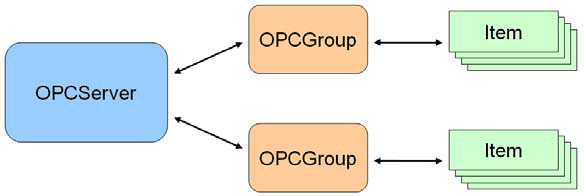CNCnetPDM enables to acquire machine, process, quality, event and alarm data from machines equipped with Siemens Sinumerik controllers and integrate it seamlessly with your business information systems. It also allows to write and change parameters on these devices.
In general communication is possible with Sinumerik 840D & 828D controllers that have an Ethernet NIC and run OS MS Windows XP or higher. Depending on the Sinumerik Software Version different communication protocols are available to exchange data between controller and CNCnetPDM:
The OPC Data Access interface allows reading, writing and monitoring of variables. The OPC DA client explicitly defines the variables (OPC items) it wants to read, write or monitor from the server. The OPC client makes this definition by establishing a connection to the OPC server first where it creates an OPCServer object, followed by creating an OPCGroup in which it can group items with identical settings such as update time in the second step and then by inserting items into the group in the third step. Figure 1 shows the different objects the OPC client creates in the server. These items can then be read or written by the client.
However, the preferred way for data exchange from server to client is monitoring during which the server, after the set update time, signals the values of items to the client that have changed since the last cycle. This means that events with changed data are also sent to the client when using OPC Data Access if the values of the selected items have changed. However, the OPC client always explicitly selects the items to be read, written or monitored.

FIG 1: OPC Data Access Overview
The OPC Alarm & Events interface allows reception of event messages and alarm messages. Event messages are single messages that inform the client on the occurrence of an event. Alarm messages are messages that inform the client on the change of a status in the process. Such a status can, for example be the execution state of a NC-Program. In this case a status change can occur when execution is interrupted due to an error or resumed after acknowledgement. Alarms usually additionally require that an alarm has to be acknowledged at the server.
OPC Alarm & Events provides a flexible interface for transmitting process alarms and events from diverse event sources. To receive data, the OPC A&E client logs on to the server and then receives all messages that occur at the server. To limit the number of messages, the OPC client can specify filter criteria. The OPC client logs on by establishing a connection to the A&E server, followed by creating an OPCEventServer object in the first step and generating an OPCEventSubscription via which the messages are received in the second step. Filters for messages can be configured on the subscription. Figure 2 shows the different objects the OPC client creates in the server. In contrast to OPC DA, there is no explicit request of specific information when using OPC Alarm & Events, but all events are provided in the process and the client can limit the number of events by filter criteria.

FIG 2: OPC Alarm & Events Overview